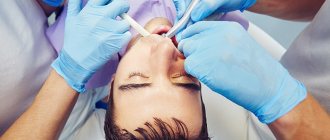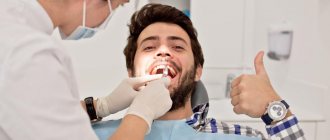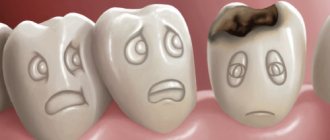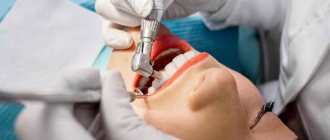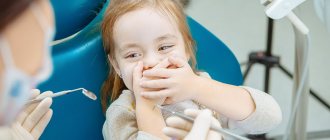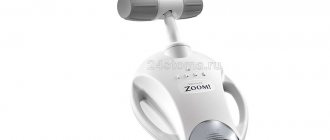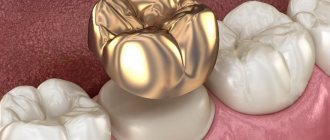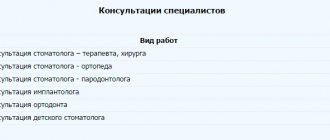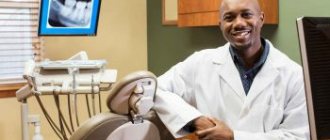Preparing for treatment
An assistant prepares for treatment. The way he carries it out will affect all aspects of the treatment process. Poor preparation for treatment does not allow the medical staff to act in a coordinated manner - there will be failures, pauses, and nervousness. Good preparation makes it possible to ensure consistency and demonstrate it to the patient.
The assistant takes into account the upcoming treatment procedures, the specifics of this appointment, as well as all the “duty” factors of the treatment process. He cooks:
- anesthesia - application and injection;
- tips - turbine and micromotor;
- burs - carbide and diamond, for the turbine tip and micromotor;
- equipment for work - radiovisiograph, electroodontometer, apex locator, piezon, physiodispenser, etc.;
- medical instruments - basic (mirror, probe, tweezers), according to the specifics of the appointment (for example, when restoring a tooth at a therapeutic appointment - a set of smoothers and pluggers). It is discussed with the doctor before the patient begins to see what additional instruments may be needed during a particular treatment;
- materials - medicinal and filling;
- dressing;
- patient medical records, referral forms;
- booklets and leaflets on the problems of patients of a specific dental profile (for example, “Treatment of caries”, “Tooth restoration with modern composite materials”, “Professional oral hygiene”, etc.);
- stationery.
The assistant’s “report” to the doctor makes a very good impression on the patient. The phrase is pronounced at the moment when the patient is given a pause to take a comfortable position in the chair.
“Maria Ivanovna! The office is ready for reception." The doctor reacts: “Thank you, Natalya! Let's get to work."
Next, the doctor indicates (reminds) the patient an action plan: what will be done, what technologies and materials will be used; reminds you of the cost of treatment agreed upon during the consultation or clarifies it in order to avoid misunderstandings after completion of treatment.
Typical shortcomings and mistakes in the “Preparation for treatment” aspect
The assistant lags behind in delivering what the doctor needs.
Causes:
- does not know what will be needed during the treatment process, and therefore waits for the doctor’s instructions before performing certain manipulations;
- does not know how to prepare the devices for operation (for example, he does not know how to “load” the patient’s card into the radiovisiograph in order to take an image; he does not know how to connect a stationary piezo and that powder and distilled water are needed for its operation);
- the office does not have what is needed, or what is needed for the appointment is not prepared in advance.
Doctor:
- prepares the necessary tools, materials, devices for work himself, without waiting for the help of an assistant (he himself takes out the necessary smoothing iron, bur, matrix, cement, composite material, etc. from the desk drawer);
- does not verbalize his requests to the assistant at the right moment, relying on his intelligence; as a result, a pause occurs and tension appears in the work of the doctor with the assistant.
What is a Dental Assistant?
A dental assistant is the same person who meets and greets the patient, invites him to enter the office, offers to make himself more comfortable in the chair, and tells him where to put things away.
First of all, of course, he is an assistant to the attending physician. He provides the necessary tools and cooperates with the doctor during the entire work process.
But his role is also to create the most comfortable conditions for the patient. It is thanks to the assistant’s friendly smile, his care and attention that many people lose their fear of the upcoming procedure.
An attentive employee will always notice what the patient needs at the moment - adjust the chair, rinse his mouth.
Before the appointment, the assistant will definitely tidy up the workplace, seat the patient in a chair with all the amenities, adjust the light and prepare the instruments.
You can ask your doctor’s assistant any questions you have about treatment - he will explain everything: from the specifics of concluding a contract for the provision of dental services to a detailed explanation of each step of the operation.
You can get advice from him about caring for your teeth and oral cavity, about different types of fillings, he can recommend toothpaste and a brush - in short, everything related to dental issues and treatment itself, the assistant will tell and explain to the patient in detail.
And if there is a child at a dental appointment, the assistant will do everything to calm and entertain the little patient.
The patient discusses the date of the next appointment with the dentist's assistant - he will call in advance and remind the person about the appointment.
An assistant is a significant figure not only for the doctor, but also for the patient.
Training course for dental assistants on video:
Equipment
The sequence of actions carried out in the patient’s field of view should be as follows:
- the assistant puts on a mask,
- then hands the mask to the doctor,
- the doctor puts on a mask,
- the assistant puts on his gloves,
- the doctor alternately offers his hands to the assistant so that he can help put on gloves,
- The assistant helps the doctor put on gloves.
Note. The equipment of the assistant and the doctor in the field of view of the patient should be carried out in the following cases: the patient has not been to the dentist for a long time and, presumably, has no idea about modern methods of ensuring the safety of treatment or has forgotten about them; suspicious person - carefully observes the actions of the medical staff; demanding patient - interested in the progress of treatment, asks questions about its safety, etc.
Equipment should be carried out out of sight of the patient if it is unpleasant for him, which can be guessed by his behavior; if he has been treated by you several times and knows that you are taking measures to ensure the safety of treatment, in particular, you have already demonstrated the equipment.
So, the assistant equips the doctor after putting on the gloves for himself.
How to help a therapist put on gloves. The assistant should take the glove to be put on by the cuff with his fingertips and turn it out, covering his fingers with the cuff, while both thumbs should be moved to the side. The glove being put on should be turned towards the doctor with the palm side. After the doctor puts on the glove, the assistant straightens the cuff on his hand.
How to help a surgeon put on gloves. The assistant hands the doctor gloves, having first put on his own. To avoid infection of the sterile surface of the doctor’s gloves, the assistant takes the glove by the cuff, while placing the tips of the index and middle fingers of both hands inside the glove, stretching the cuff, and pressing the ring and little fingers to the palms of his hands so as not to touch the doctor’s sterile gloves.
When putting on gloves, you should present them with the palm side towards the doctor, guided by the thumb. After the doctor puts on the glove, he raises his hand up, and the assistant, removing his fingers from the glove, straightens the cuff.
Typical shortcomings and errors in the “Equipment” aspect
Assistant:
- equips himself and equips the doctor behind the patient’s back (when this is not required);
- prepares gloves for the doctor of the wrong size;
- delays in preparing for treatment, forcing the doctor to equip himself;
- incorrectly (inconveniently) hands the glove to the doctor, so it is not possible to put the glove on completely.
Doctor:
- without waiting for an assistant, puts on gloves independently;
- equipped behind the patient's back (when it is not required).
Note. Some participants in the “doctor-assistant” dyad each outfit themselves independently, not only during a therapeutic or orthopedic appointment, but also during a surgical one, which is incorrect and is an anti-marker for the patient’s safety of treatment. The psychological significance of the equipment is lost: the patient is deprived of the opportunity to see the refinement of this process and the respectful attitude of the assistant to the doctor.
According to hh.ru, in Russia there are an average of 3-4 resumes per dental assistant vacancy. The employer's requirements for applicants for this position are quite ordinary: secondary specialized medical education, friendliness, ability to communicate with clients. However, rather specific and serious requirements are hidden behind formal formulations, and the candidate’s ability to fulfill them is tested only by time.
DIFFICULTIES OF SELECTION
| MIKHAIL VOLOSHKO dentist-therapist |
Experts note that there are few professional dental assistants with medical education who want to develop in this direction on the open market. And if it is possible to find an assistant in a private practice, it is already more difficult to meet the needs of a network of clinics. At the same time, entrusting the selection of an assistant to the HR department is quite a risky decision, since it is the personal selection of candidates that can answer the question of whether the assistant and the doctor can become a team.
Mikhail Voloshko, a dental therapist, says that, for example, he selects all his assistants himself. “The more work experience a doctor has, the more difficult, in my opinion, it is to find an assistant. This is due to the fact that adapting an assistant to suit yourself and a comfortable job is not a quick process. All doctors work differently, each has their own nuances in their work. The main resource for building smooth work with an assistant is time,” says the expert.
If there is no understanding in the “doctor-assistant” tandem, then the doctor has to control his work, the patient’s mood and ensure that the assistant does not make mistakes. |
Mikhail Voloshko is convinced that it is impossible to predict at the selection stage whether a doctor and an assistant will work together or not. “The doctor must see the candidate in the process of work: quality, involvement, interest. This usually takes 1-2 months. After this period, it becomes clear whether the doctor and assistant can become a team,” adds Elizaveta Afanaskina, deputy medical director of the Unident Dentistry network of clinics.
Words about the team are not pathos at all. If there is no understanding in the “doctor-assistant” tandem, then the doctor has to control his work, the patient’s mood and ensure that the assistant does not make mistakes. This can naturally affect the quality of the doctor’s work.
Elizaveta Afanaskina notes that the aerobatics of an assistant’s work is when he is able to foresee what the doctor will need. If this level of understanding is achieved, then the doctor is interested in working as long as possible in this pair.
RESPONSIBLE WORK
| ELIZAVETA AFANASKINA Deputy Medical Director of the Unident Dentistry network of clinics |
A dental assistant is not just about holding a saliva ejector and bringing materials, but about responsible four-handed work with a dentist. In addition, the assistant prepares the office for patient reception, disinfects and sterilizes instruments, and maintains medical documentation.
“The quality of compliance with Sanitary Rules and Regulations of the cleanliness regime, the quality of treatment, and the speed of receiving the patient depend on the assistant. A neat appearance, competent speech, and complete understanding with the doctor are also important,” says Mikhail Voloshko. He himself went from assistant to chief physician, so he knows exactly how an assistant should work.
Elizaveta Afanaskina adds that in modern treatment conditions, the role of the assistant has increased significantly and without him the dentist cannot perform his work professionally and efficiently. Today, the assistant must prepare and install a large number of instruments before the appointment - apex locators, ultrasonic tips, removable lighting.
In particular, a therapist’s work under a microscope is impossible without an assistant; the doctor cannot be distracted by selecting instruments; the assistant literally puts into the doctor’s hand everything he needs to carry out the procedure.
“The role of the assistant thus affects the patient’s comfort: the appointment time is reduced, and both the doctor and the patient are less tired. In addition, the important task of the assistant is to meet the patient, escort him to the chair, calm him down, and get him ready for the appointment,” concludes Elizaveta Afanaskina.
MOTIVATION AND CAREER PROSPECTS
According to the portal hh.ru, capital employers are willing to pay a dental assistant from 30 to 75 thousand rubles, depending on the clinic, experience and requirements. The average salary of a dental assistant in Russia is 41 thousand rubles.
A lot rests on the dental assistant: the comfort of the client, the quality of the dentist’s work, and therefore the reputation of the clinic. A good assistant must adhere to the ethics of “assistant-doctor” and “assistant-patient” |
Elizaveta Afanaskina notes that one of the main problems when selecting an assistant is the difference between the desired salaries of applicants and the salaries that employers are willing to pay. But this issue can always be resolved individually.
But, besides money, there are other forms of motivation, experts say. We must not forget about career prospects - this is a very important point that may interest a candidate if he is really committed to development in the profession. He will definitely be interested in learning from an experienced doctor. But for this to become possible, a “doctor-assistant” tandem is again needed, and its formation, as mentioned above, takes time.
The story of expert Mikhail Voloshko proves that the position of a dental assistant can be an excellent starting point for a great career. Although some remain in this position and prefer to grow vertically, becoming a professional assistant to a specific dentist.
Disinfection of gloves
The assistant disinfects:
- your gloves and the doctor’s gloves before starting the treatment;
- the doctor's gloves every time during the appointment, after he touched the lamp, chair, medical card, picture and other objects.
The procedure for disinfecting gloves in the patient’s field of view:
- the doctor presents his gloved hands folded in the shape of a boat,
- the assistant treats the doctor’s gloves with a disinfectant spray,
- the assistant processes his gloves.
Typical shortcomings and errors in the aspect of “Disinfection of gloves”
Assistant:
- disinfects gloves out of sight of the patient;
- disinfects gloves by spraying the spray on the patient’s face;
- delays in processing gloves, forcing the doctor to disinfect his gloves himself.
Doctor:
- without waiting for an assistant, he disinfects his gloves himself;
- presents an outstretched arm with a vertically raised palm for processing;
- based on the patient, does not ask the assistant to disinfect gloves after touching anything;
- touching something, disinfects gloves out of sight of the patient or without voicing this action to the patient.
Occupying the work area
Five reasons for the doctor and assistant to be in their work area:
- both are comfortable working in the patient’s oral cavity;
- convenient to transfer tools;
- fatigue decreases;
- the risk of occupational diseases caused by overstrain of the musculoskeletal system (diseases of the musculoskeletal system, peripheral nerves, blood vessels) is reduced;
- the patient lies comfortably in a chair.
The doctor is located in the “8-12 o’clock” zone of the abstract dial (the conventional line from 12 to 6 o’clock runs from the head to the feet of the patient lying in the chair), which gives:
- overview of the surgical field;
- the ability to accept and give instruments to an assistant.
The assistant is located in the “2-5 o’clock” zone of the abstract dial, which gives:
- the ability to take and give instruments to the doctor;
- monitor the patient's condition.
The instrument transfer zone runs in the “5-8 o’clock” zone of the abstract dial, which allows you to:
- ensure the safety of the patient and demonstrate to him the coherence of the actions of the doctor and the assistant.
The patient must be placed in a chair in such a way that it is convenient for the doctor and assistant to work and so that the patient himself is as comfortable as possible.
When finding a position in the dental chair that is comfortable for the patient, you need to:
- check with the question “Are you comfortable?”;
- ask if you want to put a pillow under your head;
- suggest wearing sunglasses;
- suggest treatment with a rubber band;
- take into account data on the patient’s health (for example, the presence of somatic diseases with a chronic course - hypertension, vegetative-vascular dystonia, heart failure, bronchial asthma, etc., as well as pregnancy, old age, excess weight);
- install the headrest taking into account the patient’s height and posture.
Typical shortcomings and errors in the aspect “Occupying the work area”
Assistant:
- does not adjust the headrest of the chair for the patient’s comfort;
- does not know how (does not consider it necessary) to place a headrest comfortably, taking into account the patient’s posture and height;
- does not voice his actions in order to show a targeted attitude towards the patient: “Sergey Petrovich, allow me, I will adjust your headrest”;
- does not ask the patient if he is comfortable.
Doctor:
- he adjusts the headrest of the chair for the patient’s convenience (this is the assistant’s task);
- does not ask the patient whether he is comfortable in the chair;
- sets the chair tilt without taking into account the patient’s health data;
- occupies the work area in the “10-14 o’clock” area of the abstract dial, thereby crowding out the assistant;
- raises the chair high, without taking into account the convenience for the assistant, who has to work while standing.
Additional Responsibilities
However, the job description does not end there. The assistant also has secondary responsibilities.
They include:
- General cleaning of the office once a week - including washing the walls and ceiling.
- Window cleaning according to schedule.
- Meeting the patient at the reception desk and accompanying him to the office.
- Attendance at meetings, conferences, and official events.
- Providing emergency medical care to the patient if required.
The dental assistant, like other clinic employees, participates in the discussion of work issues, makes suggestions for improving the activities of the institution and the provision of services, and makes comments.
The doctor and assistant actively cooperate, jointly conduct the process of medical care, and consult. The doctor and assistant act together harmoniously - like a single organism.
Assistant training process on video:
Setting the lamp light at the beginning of treatment
Note. A dental unit lamp is a device for illuminating the surgical field in the patient’s mouth. The radiation intensity of the lamp in modern installations is more than 20,000 Lux. There is a light intensity regulator.
The assistant turns on and directs the light of the dental unit lamp, taking into account:
- will it be convenient for the doctor to work;
- Will the patient be comfortable?
Assistant actions:
- before turning on the lamp, offers the patient sunglasses,
- the lamp is first directed to the patient's abdominal area,
- then the lamp light turns on,
- the light of the lamp moves to the area of the lower third of the face.
Typical shortcomings and errors in the aspect “Installing the lamp light at the beginning of treatment”
Assistant:
- does not offer sunglasses to the patient before treatment;
- early, a few minutes before the start of the examination, turns on the lamp light;
- incorrectly sets the lamp light - either it hits the patient’s eyes, or is directed past the doctor’s working area in the patient’s mouth (the doctor is forced to change the position of the lamp);
- forgets to lower the installation bracket with the lamp down, forcing the doctor to get up from the chair to set the lamp light in the desired position.
Doctor:
- does not offer sunglasses to the patient before treatment unless the assistant does so;
- without waiting for the help of an assistant, he himself lowers the installation bracket with the lamp;
- sets the position of the lamp relative to the patient’s lower or upper jaw.
Who can hold this position
Orders of the Ministry of Health answer the question of how one can become a dental assistant. This position is predominantly filled by nurses or nurses with secondary education. In practice, a dentist can be assisted by a paramedic or an inexperienced graduate of the dental faculty of a university with a nursing certificate. It's easier to finish nursing in college in just a few years so you can get a job in a clinic and gain experience. Paramedic or, especially, medical training specifically for working as an assistant is not needed.
College graduates often ask the question: how to become a medical assistant without experience or special training? The nursing faculty program practically does not touch upon dentistry, so graduates are sometimes not confident in their knowledge and skills. In fact, clinics often recruit nurses for further education, so with due diligence, finding a job after receiving your diploma will not be difficult. At the same time, quick learning is one of the fair requirements for candidates for employment.
Light adjustment
Assistant:
- directs the light of the lamp so that it directly illuminates the area in the patient’s oral cavity required for examination or treatment;
- sets the lighting differently for each jaw: when working on the lower jaw, the light is directed straight down; when working on the upper jaw, the light should be directed at an angle;
- makes sure that the light does not shine in the patient’s eyes;
- promptly turns on, turns off and adjusts the brightness of the lamp depending on the stage of treatment (for example, when selecting burs or working with light-curing materials, the lamp light should be dimmed).
Notes:
- the assistant should be able to reorient or turn off the lamp at any time, so it should be at a distance no further than his outstretched arm;
- The assistant turns off the lamp light in the following cases:
- every time a doctor talks with a patient, discussing a treatment plan (prosthetics), giving recommendations, making a prognosis;
- when determining the color of a future restoration or prosthesis, when natural lighting is needed.
Typical shortcomings and errors in the “Light adjustment” aspect
Assistant:
- incorrectly sets the light of the installation lamp - the area of the surgical field is not illuminated or is not illuminated enough;
- does not dim the brightness of the lamp when working with light-curing materials in the patient’s oral cavity;
- does not turn off the lamp light when it is possible to give the patient a rest (for example, when changing the bur).
Doctor:
- adjusts the light of the lamp independently, not trusting the assistant to do this or anticipating his actions when he is slow.
Key Knowledge
The assistant must have basic skills in medicine, as well as be a professional in his field. The young specialist has a secondary medical education (college, technical school, school) with a specialty in nursing.
Periodically, the employee undergoes certification to confirm his knowledge.
This is what the qualification requirements look like in an employment contract for a medical worker of this profile:
| Conditions for tenure | Requirements |
| Education | Specialized secondary |
| Speciality | Nursing |
| Work experience by profession | From 1 year |
| Professional recertification | Once every 6 months |
Since the assistant, in addition to assisting the doctor, also resolves controversial issues with visitors and keeps a journal, his knowledge is not limited to narrow-profile ones.
Here is a complete list of what the assistant should know:
- laws regulating the activities of healthcare institutions and other norms and acts relating to order in this area;
- labor Code;
- how to organize medical dental care at a basic level;
- structure and functions of the jaw and teeth;
- biological mechanics of the masticatory apparatus;
- theory of treatment of the most common orthopedic pathologies;
- how to organize preventive medical dental care for children and adults;
- about methods of preventing dental diseases;
- about how to properly care for the oral cavity;
- rules for sanitary treatment of dental premises;
- methods of providing emergency medical care;
- safety precautions;
- basic principles of working with a computer and documentation (PC operator);
- rules of etiquette.
As you can see, a junior employee needs to know quite a lot.
Supply of tools and materials
The assistant gives the doctor: a carpule syringe with anesthetic, instruments, materials that are needed at this stage of treatment, a machine tip with a bur.
Rules for administering anesthetic:
- the assistant hands over the carpule syringe, clearly naming the anesthetic,
- the doctor intercepts the syringe,
- the assistant removes the protective cap from the needle,
- both partners verbally and non-verbally relax the patient.
Ten rules for filing instruments
- Never pass instruments over the patient's head or face.
- The assistant passes the instrument over the patient's chest so that he does not experience discomfort.
- In the case of transferring a surgical instrument (for example, forceps for tooth extraction), it is allowed to transfer it behind the patient's head.
- Always hand the instrument to the doctor with the working end towards the tooth being prepared so that the handle of the instrument is in the closest and most convenient position for gripping to the doctor’s leading hand.
- Handle sharp instruments or instruments with two handles (forceps, scissors) carefully to avoid injury to the patient or doctor.
- Avoid collision of the assistant's hands with the doctor's hands.
- The required instrument must be placed in the hands of the doctor in such a way as to ensure interception and prevent the instrument from falling.
- The instrument must be given and received in such a way that the doctor’s hand makes as little movement as possible.
- Do not pick up the instrument if it has fallen to the floor.
- If the instrument falls on the floor, then you should note to the patient that you will replace the instrument with a sterile one. Otherwise, the patient may view the instrument falling as a situation that prevents treatment from continuing properly.
Note. When the assistant puts the protective cap on the carpule needle after injecting the anesthetic, he needs to be as careful as possible and not rush, so as not to injure himself - a needle prick. Please remember that the needle can become infected.
Typical shortcomings and errors in the aspect “Supply of tools and materials”
Assistant:
- untimely or late provides the doctor with the necessary instrument or material, because he does not know or does not understand what the doctor will need next;
- does not know the technique of mixing cements, impression materials (when manually mixing dental cements and impression materials, it is necessary to strictly take into account the ratio of components determined by the manufacturer, the mixing time and the homogeneity of the resulting material);
- hands the doctor instruments over the patient's face or head - there is a danger of injuring the patient and frightening him;
- the instrument is transferred within the patient’s field of vision, which causes psychological stress;
- is in a hurry or abrupt in movements with instruments - there is a danger of injury to the patient or doctor;
- does not announce the name of the anesthetic, material, instrument to the doctor - an error may occur, so the doctor is forced to double-check the assistant by asking questions.
Doctor:
- he himself takes the necessary tools from the cassette (tray), without relying on the timely help of an assistant or without trusting him;
- does not verbalize the request for the assistant to submit the necessary, relying on his intelligence, as a result, the treatment process slows down, the doctor begins to get nervous.
Job responsibilities
What is the main job of the employee:
- Preparing the office for receiving clients and for the work process. First, the worker wet cleans the room using disinfectant cleaning agents and ventilates the space. According to the schedule, it carries out antimicrobial and antiviral air treatment using a quartz lamp.
- Preparation of the necessary tools and materials that will be involved in the work process. The employee must sterilize reusable instruments and ensure that disposable ones are in suitable condition. If necessary, make blanks of working material - for example, an impression for crowns.
- Preparation of medicines.
- Providing dressings and auxiliary materials - cotton swabs, napkins, bandages, gauze, napkins.
- Assisting the doctor during medical procedures, accurately following the doctor’s instructions.
- Administration of anesthesia to the patient.
- Ensuring client comfort.
- Caring for the patient - the assistant must promptly offer a glass of rinsing and ensure that there are no medication residues on the face and clothes.
- Maintaining records in reception and control logs, maintaining documentation, filling out paper documents.
- At the end of the working day, the dental assistant performs the same procedures as in the morning - cleaning the room, sterilizing instruments.
A dental assistant is a responsible position. It is the junior employee who is responsible for the safety and cleanliness of tools and the serviceability of equipment. If an employee discovers any malfunction of equipment or a breakdown of an instrument, he informs the doctor and the administration of the institution about this and makes a note about it.
The assistant ensures that all necessary medications and materials are available and in sufficient quantity, and keeps a constant record of these funds.
Informing the visitor is also his responsibility. The employee must notify the patient about the side effects of the medications used and warn about possible pain.
The assistant is responsible for the accuracy and reliability of all production records and for the safety of documentation.
The junior employee is rightly called the “right hand” of the dentist.
Dental assistant job description can be found here.
take, intercept, hold
The assistant takes or intercepts the instrument from the doctor’s hands.
The doctor takes or intercepts the instrument from the assistant’s hands.
Typical shortcomings and mistakes in the “Take, intercept, hold” aspect
Assistant:
- does not know how to replace instruments from one to another, does not know how to hand instruments to the doctor;
- does not know or does not foresee what instrument the doctor will need at the next moment (for example, during restoration of a tooth with a composite material);
- does not come to the doctor’s aid during treatment when it is necessary to hold the patient’s cheek or tongue, matrix, or suture material;
- is in a hurry or abrupt in movements with instruments - there is a danger of injury to the patient or doctor;
- does not comment on his actions for the doctor and patient if necessary.
Doctor:
- relies only on himself, because he does not count on the effective help of an assistant or does not trust him;
- does not verbalize the request for the assistant, unreasonably relying on his intelligence.
Working with four hands or why does a dentist need an assistant?
Ergonomics in dentistry – four-handed work. In recent years in Russia, the system of working “with four hands” has begun to be actively introduced into the practice of dentists, i.e. one doctor plus one nurse near the chair with the patient.
According to WHO and the International Federation of Dentists (FDI), back in the seventies, for each dentist there were 1.28 support staff in Germany, in England - 1.19, in Norway - 1.02. In the USA, each dentist is assisted in his work by an average of 1.3 assistants, including about 2% of doctors use the services of three assistants and 10% have two assistants.
Why does a dentist need an assistant? Firstly, the assistant frees up the doctor’s time for more complex procedures that require high qualifications. Research has shown that dentists spend an average of 25 to 40% of their time performing assistive procedures that can be delegated to assistants. This allows dentists to increase productivity by 40–60%.
Secondly, it is almost impossible to conduct a modern appointment without an assistant, since compliance with infection control requirements, compliance with filling technologies with light-curing materials, and requirements for the use of modern dental equipment and instruments is simply impossible to fully complete without an assistant. A dentist working with a nurse is 50% more efficient than a dentist working without a nurse.
Advantages of four-handed technology
— high labor productivity due to the separation of the functions of a doctor and an assistant; — maximum use of the knowledge and skills of an experienced doctor; — reduction of psychological and physical discomfort in patients; — the possibility of using high-quality medical technologies; — reduction of dentist fatigue due to stress during the working day; — good adaptation of the patient in a horizontal position; — maintaining health and extending the period of active practice of a doctor through the rational organization of the workplace and workload relief at the expense of assistants.
Proper and ergonomic organization of your workplace and work process can significantly save time, effort and, most importantly, the health of both the doctor and the patient! In the dental clinic, TIM-dent work with four hands is carried out when performing any procedures.
Replace
The assistant changes depending on the stage of reception:
- boron in a mechanical, turbine tip;
- tips on the physiodispenser in accordance with the required speed limit;
- roller balls in the patient’s mouth;
- the instrument used for the next stage of treatment;
- broken, dirty, sterilized instrument in a cassette.
Note. Opening a package with a sterile instrument should make as little noise as possible, especially if the doctor is talking to the patient at this time. The doctor, while the assistant is replacing something, has the opportunity to:
- offer the patient a break to rest;
- maintain contact with the patient;
- inquire about his well-being;
- inform the patient about the upcoming procedure or stage of treatment;
- relax.
Typical shortcomings and errors in the “Replace” aspect
Assistant:
- cannot replace burs in the handpiece, equipment (for example, a device for removing hard plaque (piezon) with a device that removes pigmented plaque - air flow, used instruments in a cassette (tray) due to ignorance or misunderstanding of the essence of the manipulation being performed;
- does not comment on his actions for the doctor and the patient in the event of a pause when replacing something;
- with noise, in response to the doctor’s phrase addressed to the patient, he opens the package with a sterile instrument;
- does not invite the patient to rest, relax, using a pause in work when something is replaced.
Doctor:
- replaces burs, instruments, roller balls in the patient’s mouth (in simple cases), without relying on the effective assistance of an assistant or not trusting him;
- does not verbalize the request for the assistant, unreasonably relying on his intelligence;
- does not fill the pause with communication with the patient when something is replaced.
Adjusting modes
The assistant regulates:
- operating modes of devices (for example, piezon, apex locator, physiodispenser);
- office lighting when selecting the color of a future tooth restoration or orthopedic structure;
- modes of water and solution supply to the dental unit located in its access zone.
Typical shortcomings and errors in the aspect “Adjusting modes”
Assistant:
- cannot change certain modes (operation of devices, light brightness, speed of supply of water, solutions in the installation or equipment), because he does not know where the regulator is located or does not know how to operate it;
- does not change regimens in a timely manner because he does not understand the essence of the manipulation performed by the doctor;
- does not comment on his actions for the doctor and patient if necessary;
- does not invite the patient to rest or relax when there is a pause when changing certain modes.
Doctor:
- he himself regulates the operating modes of devices, equipment, dental units located in the assistant’s access zone, without relying on the assistant’s help or not trusting him;
- does not verbalize the request for the assistant, unreasonably relying on his intelligence;
- does not fill the pause with communication with the patient when you have to wait while something is adjusted.
Dry
Assistant: dries the surgical field with gauze balls, works with a water aspirator to remove bone chips and excess fluid from the surgical field in the patient's mouth. Liquid and solid residues in the patient's mouth are removed using evacuators (aspirators).
Evacuators are devices for removing water, saliva and solid residues that arise during the processing of dental tissue.
Evacuation is necessary so that the doctor can see the surgical field, and also to prevent the development of asphyxia in the patient. All modern dental units are equipped with tow trucks. For convenience in work, use the tips of evacuators - a vacuum cleaner and a saliva ejector.
A saliva ejector is used to remove saliva from the mouth during dental procedures without using a water jet. Has a small evacuation tip consisting of a flexible, easily replaceable, disposable plastic tube.
A vacuum cleaner is used to remove water, saliva and solid residues, as it has a greater vacuum force than a saliva ejector. It has a larger diameter than a saliva ejector, a working hose, and a more voluminous tip. Vacuum cleaner tips are reusable and disposable.
Eight rules for working with a vacuum cleaner and saliva ejector
- Do not hit the tip of the vacuum cleaner on your teeth, lips or gums - this can damage their tissue and cause discomfort to the patient.
- Avoid sucking soft tissues of the oral cavity into the handpieces (especially a vacuum cleaner) - this can contribute to the formation of a bruise or cause an unexpected reaction from the patient, even fear, he may recoil from unexpected sensations when the doctor works in the oral cavity with a rotating instrument.
- Dose the vacuum effect depending on the work being done and the amount of liquid and solid residues to be evacuated. This is done using a valve in both tips. A strong vacuum effect, for example when working with a saliva ejector in the sublingual space, can lead to dryness of the mucous membrane. The patient experiences dry mouth, sore throat and may interfere with the doctor’s work.
- The tips of the saliva ejector and vacuum cleaner should not be placed on the root of the tongue, in the area of the pharynx and soft palate - this may cause a gag reflex in the patient.
- Fix the tip of the vacuum cleaner in the patient’s mouth while the doctor works with the tip of the drill. When moving the tip of the vacuum cleaner, you may accidentally hit the tip of the drill and cause injury to the patient.
- Do not rest the tip of the vacuum cleaner on your gums, lips, tongue or teeth.
- Place the tip of the vacuum cleaner at a distance of one tooth from the tooth being prepared.
- When working as a tow truck, make sure not to block the doctor’s view and access to the surgical field.
Ways to grip the vacuum cleaner tip
A. Palm and thumb holding method (universal) - take the tip with your right hand so that the hose is on the thumb side, and the thumb and index fingers are on the shut-off valve. The tip is completely clamped into the palm. This gripping method is especially convenient when working in sectors II and III of the dentition.
B. The method of holding the “fishing rod” is to take the tip with your right hand so that the hose is on the little finger side, and the thumb is on the shut-off valve. This gripping method is usually used when working in the first sector of the dentition.
B. The method of holding a “writing pen” is to take the tip with your right hand in the same way as with method A, with the difference that the fingers - the little finger and the ring finger - do not clamp the tip, but are positioned along it. In this case, the thumb and forefinger are on the shutoff valve valve. This method is used when working in distant sectors - I and IV - of the dentition.
Note. The gripping methods depend on the type of shutoff valve. If the valve is screwed on (looks like a washer), then methods A or B must be used. If the valve is in the form of a lever and is controlled by one thumb, methods A or B must be used.
Techniques for gripping and installing a saliva ejector
The saliva ejector is grasped in such a way that the thumb and forefinger are positioned on the shut-off valve, and the remaining fingers along the tip. The hose is located on the little finger side. The gripping technique is similar to the gripping technique B of the tip of a vacuum cleaner.
When the assistant is busy preparing instruments or filling material, the saliva ejector is installed permanently, usually in the sublingual space. To secure the saliva ejector, the flexible tip is bent in accordance with the anatomical structure of this area of the lower jaw.
Typical shortcomings and mistakes in the “Dry” aspect
Assistant:
- does not have time to remove fluid from the patient’s mouth during treatment;
- in simple cases of treatment, does not change the roller balls in the patient’s mouth in a timely manner;
- does not know how to install an air aspirator (“vacuum cleaner”) conveniently for the doctor’s work - it blocks access to the working area in the oral cavity;
- causes discomfort to the patient by his actions, for example, with the tip of a vacuum cleaner he presses hard on the gums or hits the teeth;
- does not monitor whether the doctor is comfortable when working with aspirators;
- does not monitor the patient's condition.
Doctor:
- takes over the work with the water aspirator;
- does not trust the assistant to replace roller balls in the patient’s mouth in simple cases of treatment.
Shine with curing lamp
The doctor applies an adhesive system into the tooth cavity (or onto a ceramic structure), places a portion of light-curing material, restoring the tooth cavity.
The assistant monitors the doctor’s actions in the patient’s oral cavity; prepares the solar lamp, setting the desired mode; highlights a portion of the introduced material.
Typical shortcomings and errors in the aspect “Shine with a polymerization lamp”
Assistant:
- did not prepare the polymerization lamp for reception, it is turned off from the network or the battery is discharged;
- works with a lamp without protective glasses or a shield, violating personal safety precautions;
- illuminates the material in less time than is necessary in this case;
- presses the nozzle of the polymerization lamp to the filling material;
- highlights the material from the wrong side.
Doctor:
- takes upon himself the illumination of a portion of the material, without trusting this to an assistant;
- does not verbalize instructions to the assistant on how best to cover the material in a given case, unreasonably relying on his intelligence;
- violates safety regulations by monitoring the actions of an assistant while illuminating material without protective glasses or a face shield;
- does not explain to the patient (in justified cases) at what stage the tooth restoration is carried out and how long until completion.
Features of the specialty
A dental assistant is a representative of nursing staff who assists a doctor. Patients usually meet such a specialist first when visiting a dental office. Assistants fill out primary documentation, conduct interviews and prepare everything necessary for carrying out diagnostic and treatment procedures. Experienced representatives of this profession make the dentist’s work much easier.
The main responsibilities of a medical assistant:
- preparing the office and equipment for work, including cleaning and disinfection;
- independent documentation maintenance, entering data into electronic databases, recording patient records;
- initial examination of the patient’s oral cavity to detect pathological conditions;
- collection, storage and processing of biological materials for diagnostics;
- hygienic treatment of the oral cavity;
- first aid in case of emergency conditions in dentistry;
- preparing patients for therapeutic and diagnostic procedures;
- assisting a doctor during the prevention, diagnosis and treatment of diseases;
- patient consultation on oral hygiene issues;
- obtaining dental impressions;
- injection of painkillers.
The job responsibilities of an assistant may vary from institution to institution. The dentist decides what can be trusted to his colleague. Most of the time, such workers hand instruments to the doctor, fill out paperwork, and operate various equipment.
Put away
The assistant cleans:
- in the patient’s oral cavity: rolls, balls, retraction threads, fragments, crumbs;
- contamination from the patient's face and glasses;
- contamination from working tools;
- moves the armrest and table of the dental unit at the end of treatment; instruments into the cassette from the dental unit table.
Typical shortcomings and errors in the “Remove” aspect
Assistant:
- waits until the doctor reminds him to help remove balls, rollers, retraction threads, fragments of hard tooth tissue, crumbs of filling material, dirt from the patient’s glasses and the doctor’s mirror from the patient’s mouth during treatment;
- does not notice dirt on the patient’s face remaining after treatment, hygienic cleaning, or taking impressions;
- does not warn the patient that he will remove something from his face, and does this unexpectedly for the patient;
- when necessary, does not comment on his actions for the doctor and the patient.
Doctor:
- acts for the assistant, removing balls, rollers, retraction threads, fragments of hard dental tissues, crumbs of filling material, dirt from the patient’s glasses and doctor’s instruments from the patient’s mouth;
- does not remind the assistant of the need for specific actions when he is not performing his duties.
Search for a dental assistant
One of the in-demand vacancies in the medical staff market is a dental assistant. This vacancy is readily accepted by aspiring doctors who do not have sufficient medical practice and who want to gain the necessary experience and skills in order to open their own medical office in the future. But don’t think that finding a good dental assistant in Moscow is easy. Here we are talking about finding qualified personnel. To work as a dental assistant, you must have the appropriate education. For this category of specialists, not only professional knowledge is important, but also human qualities. Many patients are terrified of visiting the dental office, especially for children. They associate the dentist with pain, although modern dentistry can be completely painless. A dental assistant helps the patient get ready for procedures, provides moral support, assists the doctor during procedures, and performs simple manipulations. Finding a dental assistant in Moscow who knows how to approach a patient is a task for experienced headhunters. provides a guarantee for its work. If the found specialist does not meet the criteria or does not complete the agreed probationary period, we will replace him with another employee.
Track
The assistant monitors during the treatment session:
- the start and end time of the appointment;
- the patient's condition;
- the speed of the doctor’s actions;
- over time during individual manipulations: applying orthophosphoric acid, fluoride gel, taking impressions, carrying out the whitening procedure, etc.;
- for the availability of the necessary materials, tools, ball rollers on the table of the dental unit;
- ensuring the cleanliness of the doctor’s dental instruments (use a gauze ball to remove traces of contamination from a dental mirror, plugger, smoother, etc.);
- behind my actions: “Am I doing everything as I should”, “Am I having time to help the doctor”, “Am I disturbing him”, “Am I bothering the patient with my actions.”
Typical shortcomings and errors in the “Track” aspect
Assistant:
- does not pay attention to the patient’s well-being during treatment because he does not have time to do this or does not see signs of his physical discomfort;
- waits for reminders from the doctor regarding the preparation of what is needed for the next stage of treatment;
- waits for the doctor’s reminders to monitor the timing of the manipulation;
- waits for instructions to put dental instruments and table in order;
- does not monitor his actions to check their correctness, direction, speed, synchronized with the doctor’s actions.
Doctor:
- takes complete control over the patient's well-being, not trusting the assistant or not considering it necessary to include him in interaction with the patient.
Self-test questions
- What does the concept of “coordination of the actions of the doctor and the assistant” include?
- What does the patient experience and what conclusions does he draw from observing the coordinated actions of the doctor and assistant during treatment?
- Do you find it appropriate to report to the doctor in the presence of the patient before starting treatment that everything is ready for the appointment?
- Why does the doctor equip himself before starting treatment?
- What, how and in what sequence do the doctor and assistant do during the equipment before starting treatment of the patient?
- What is special about helping a surgeon put on gloves?
- When should doctor’s gloves be disinfected during an appointment?
- Why do the doctor and assistant need to properly occupy their work area?
- What is the sequence of actions when installing and turning on the light of the dental unit lamp before starting treatment?
- When should the assistant turn off the dental unit light during treatment?
- What does the assistant give to the doctor during treatment? When should he voice what he is giving to the doctor?
- What are the biggest mistakes assistants make when presenting instruments to the doctor?
- What does an assistant replace during a therapeutic appointment?
- What can cause physical and psychological discomfort to the patient during “replacements”?
- What modes of which devices does the assistant regulate during the treatment process?
- What actions of an assistant when working with a vacuum cleaner and saliva ejector can injure the patient and how?
- What mistakes does the assistant make that harm him when he works with the curing lamp in the patient's mouth?
- What does the assistant monitor during the treatment appointment?
- In what ways does the assistant interfere with the doctor’s work with the patient?
- Why doesn't the assistant think about how and when he interferes with the doctor's work?
How to find a dental assistant in Moscow
If the staff is recruiting, then first of all we will check our own candidate database. If the proposed candidates are not enough, we will start a search for a dental assistant using a resume. The search is carried out in vacancy databases on the Internet and regional media. We will post vacancies “looking for a dental assistant” on specialized websites on the Internet and printed publications. We will process all applicant resumes received. From these, the candidates who meet the criteria are selected. We first interview the selected candidates ourselves. We pay attention to work experience, professional skills, temperament and character. The initial interview can take place either with or without a customer representative. Selected candidates are presented to the potential employer. Before hiring, we recommend a personal conversation with the immediate supervisor of the future employee. Knowledge of modern methods of personnel selection allows you to find a dental assistant in Moscow who fully meets the criteria of the most demanding customer. Cooperation with TOTAL contributes to the effective development of your business. To clarify the conditions for searching for a dental assistant, contact the agency manager.
